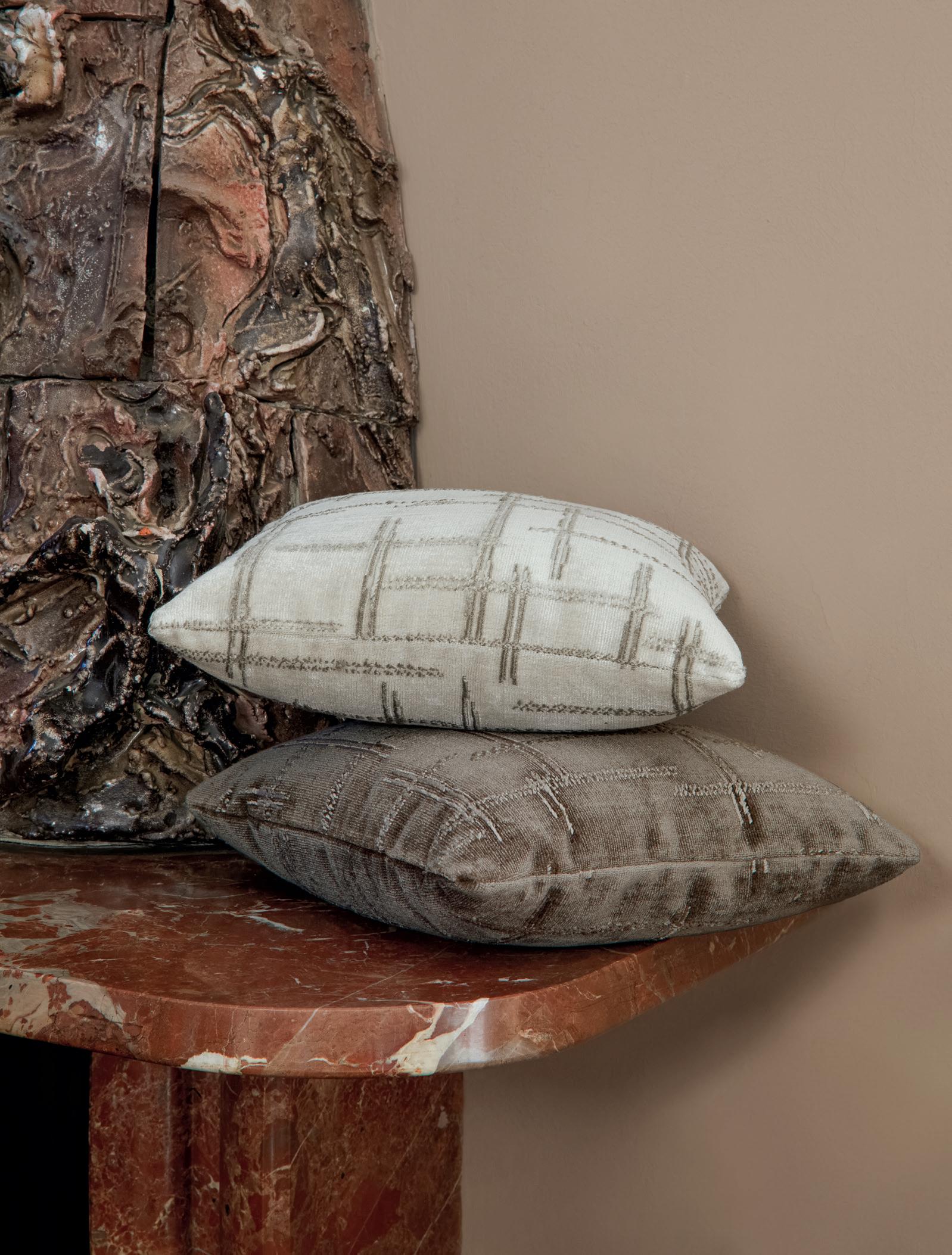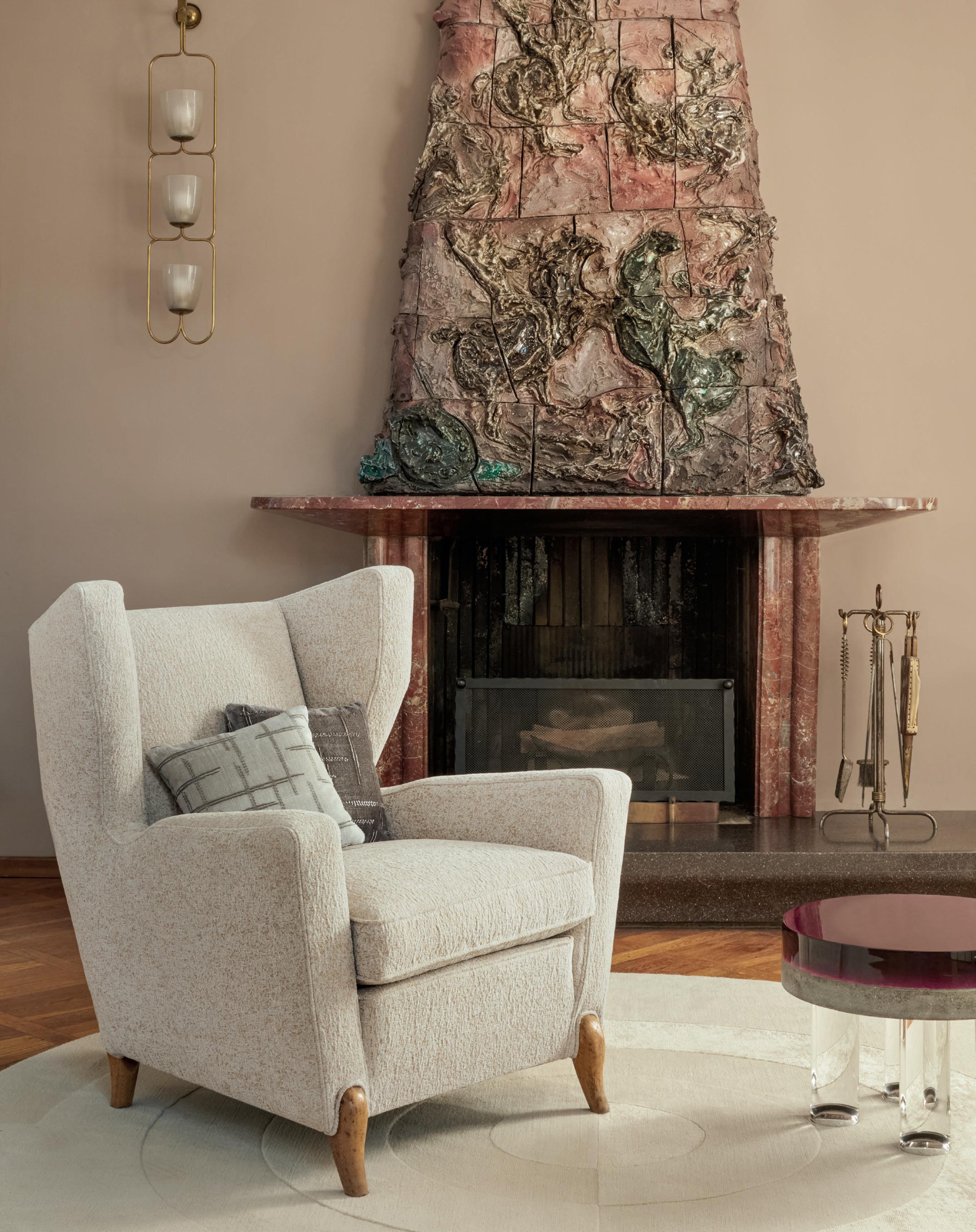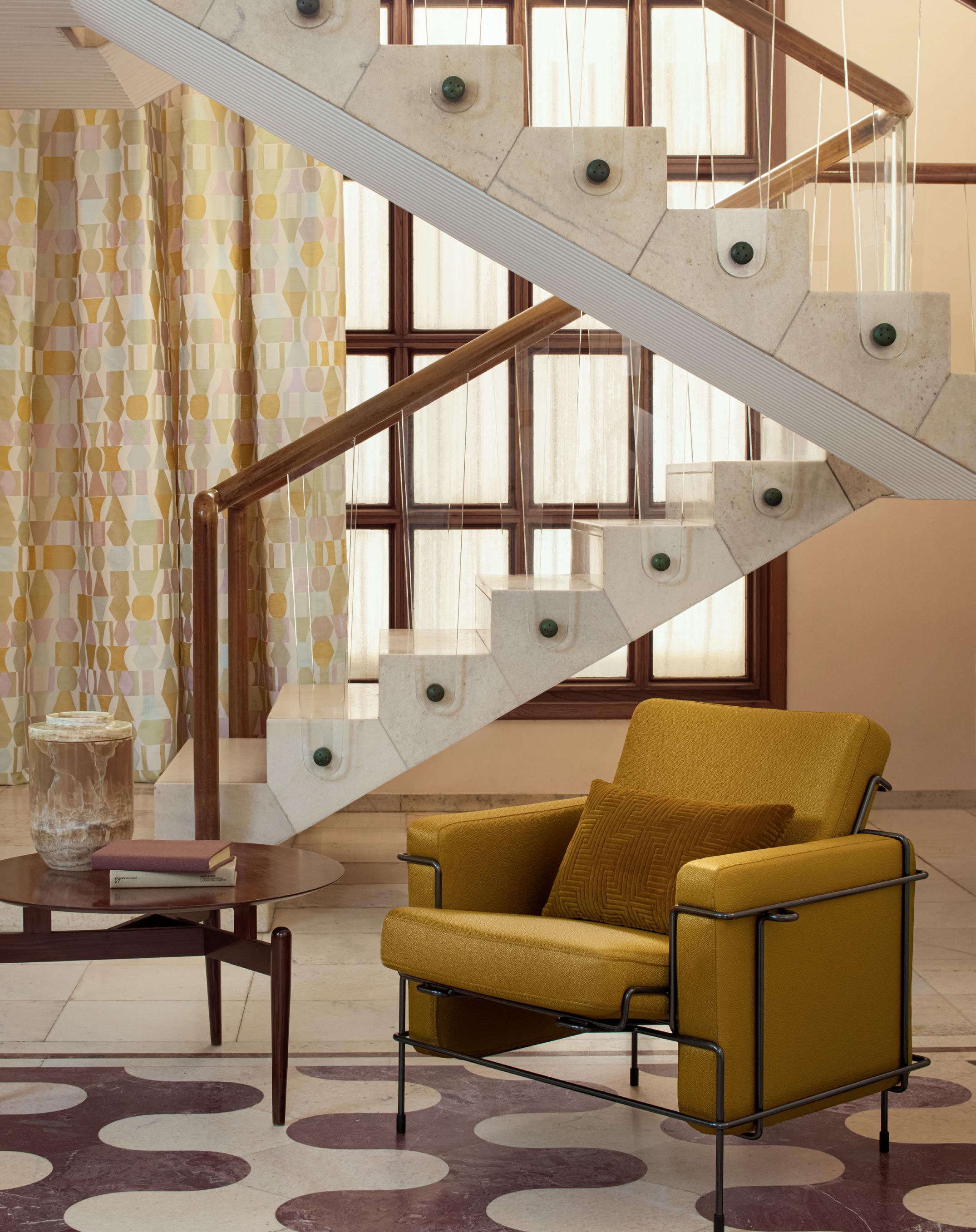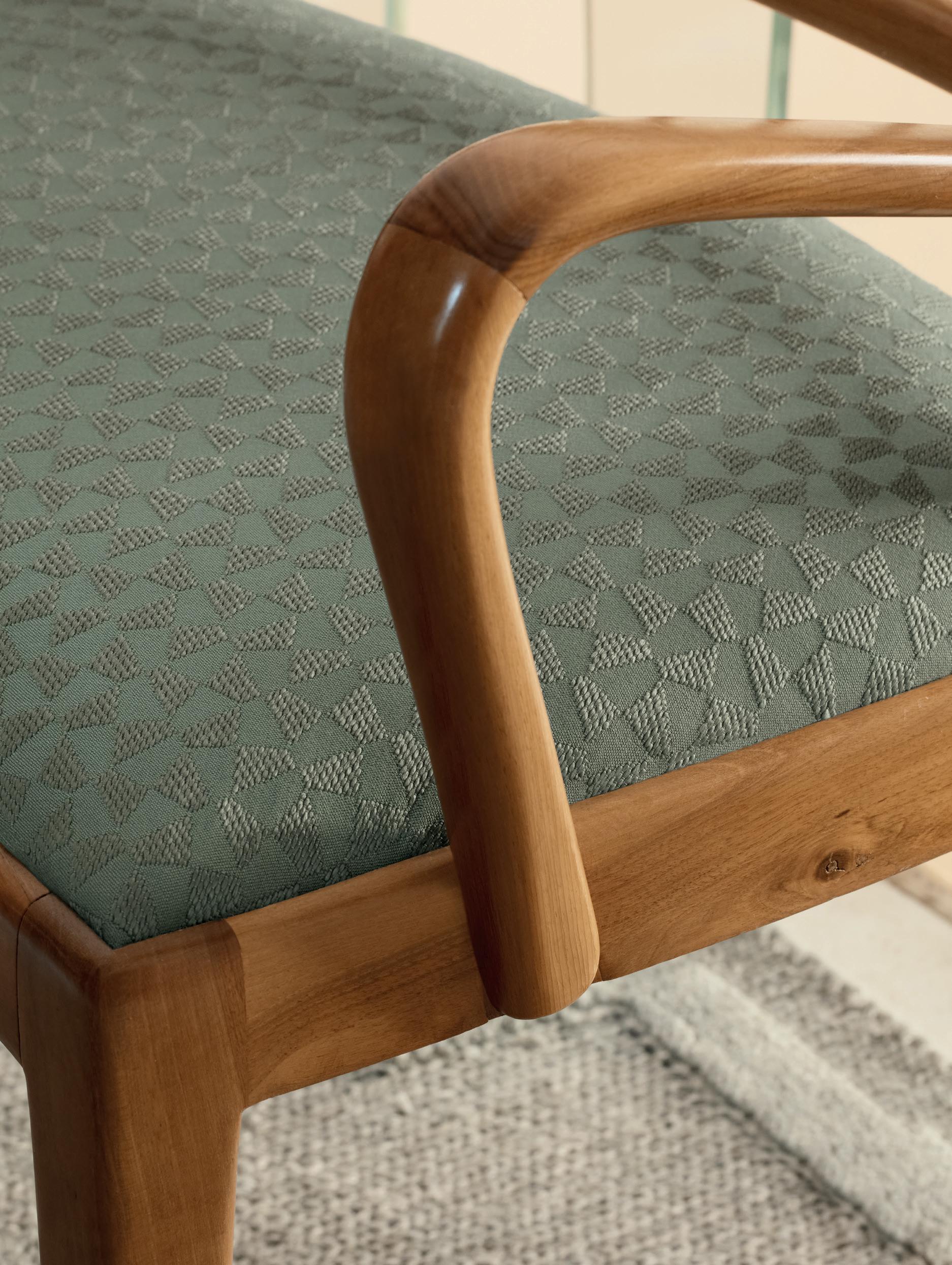TEOREMA

In order
Background Sophie 30713-7, Armchair by Avanguardia Antiquaria Frank 30708-11
Background Kyoto 30706-6, Ginevra Sofa by Quinti Sherlock 30700-22
Background Ola 30719-1, Le Bambole Armchair by Officina Antiquaria 900 James 30705-6
Background Shanghai 30704-38, Figura Armchair by Rubelli Casa Marple 30702-6 (backrest and seat), 30702-11 (sides) and 30702-10 (armrests)
Background Sharky 30703-11, Domino Chair by Rubelli Casa Scratch 30711-3
Background James 30705-12, Elettra Armchair by Arflex Fortunato 30710-6
Background Zigzag 30712-2, Neptunia Chair by Arflex Martora 30709-35











It is said that weaving is one of the first arts developed by humankind. Born to satisfy practical needs, it has been ennobled by the creativity of those who over time have skillfully woven threads of different nature.
Last year, visiting the 60th Venice Art Biennale, I was surprised by the large number of textile works. In reality, this is not new: ninety years earlier –at the 19th Biennale – many fabrics were on display. Of these, a remarkable 18 were developed and produced by Rubelli based on designs and projects by artists such as Gio Ponti or Vittorio Zecchin. This is a clear recognition of the fact that fabric, in addition to its practical function, can become an artistic expression. This concept is not foreign to us, considering that our goal has always been to create fabrics that combine functionality and aesthetics (I proudly affirm that the prestigious EDIDA award, assigned to us three times in five years, confirms that Rubelli is able to achieve this goal).
Fabric moves, excites, amazes, tells stories – just like a work of art.
Fabric is our passion, and the 2025 collection celebrates it in its various forms and materials: natural fibres such as wool, silk, linen or cotton, and high-performance technical fibres. Light and delicate fabrics for draping, as well as textured fabrics for upholstery. Plain colours, textures, decorative designs, and geometric patterns. As for colours, neutrals prevail, but colour is not lacking. All these elements mix and merge as if to form a mathematical formula and generate a perfect theorem. That’s why Teorema is Rubelli’s 2025 collection.
What you discover in the pages of this book is our ode to textiles and a tribute to the mastery that gives life to every new collection. Our Teorema is completed, and we now entrust it to you, confident that – like new Euclids – you will be able to prove its validity.
ODE AL TESSUTO
Si dice che la tessitura sia una delle prime arti sviluppate dall’uomo; nata per soddisfare esigenze pratiche e resa nobile dalla creatività di chi nel tempo ha saputo intrecciare sapientemente fili di diversa natura.
Lo scorso anno mi sorprese, visitando la LX Biennale d’Arte di Venezia, il grande numero di opere tessili.
In realtà, non si tratta di una novità: già novant’anni prima – alla XIX Biennale – erano esposti molti tessuti. Di questi, ben 18 sviluppati e prodotti da Rubelli su disegni e progetti di artisti quali Gio Ponti o Vittorio Zecchin. Un evidente riconoscimento del fatto che il tessuto, in aggiunta alla funzione pratica, può diventare espressione artistica.
Concetto che non ci è estraneo, considerato che da sempre il nostro obiettivo è creare tessuti che combinino funzionalità ed estetica (affermo con orgoglio che il prestigioso premio EDIDA, assegnatoci tre volte in cinque anni, dimostra che Rubelli è in grado di centrare l’obiettivo).
Il tessuto emoziona, stupisce, entusiasma, racconta storie – proprio come un’opera d’arte.
Il tessuto è la nostra passione, e la collezione 2025 lo celebra nelle sue diverse forme e nei diversi materiali: fibre naturali quali lana, seta, lino o cotone, e fibre tecniche dalle prestazioni elevate.
Tessuti leggeri e delicati per il drappeggio, così come tessuti strutturati per gli imbottiti. Tessuti uniti, tessuti materici, disegni decorativi e disegni geometrici. Quanto alle cromie, prevalgono i neutri, ma non manca il colore. Tutti questi elementi si mescolano e si fondono come per dare forma ad una formula matematica e per generare un teorema perfetto. Ecco perché Teorema è la collezione 2025 di Rubelli.
Quello che scoprite nelle pagine di questo libro è la nostra ode al tessuto ed un tributo alla maestria che sa dare vita ad ogni nuova collezione.
Il nostro Teorema è completato e ora lo affidiamo a voi, certi che – come dei novelli Euclide – saprete dimostrarne la validità.
Nicolò Favaretto Rubelli
January 2025
Nicolò Favaretto Rubelli
Gennaio 2025
At first glance, Teorema appears as a highly innovative collection, and in many ways unprecedented in the Rubelli world. In reality, it is the natural evolution and expansion of Gardens, the first collection presented under the creative direction of Formafantasma in 2024.
Teorema is born from very simple principles, as the name suggests.
As in Gardens, the first principle in Teorema is that of colour, which must be coherent and versatile throughout the entire collection. The choice of neutrals is wide, accompanied and complemented by fresh and extroverted colours that are harmoniously declined in the various fabrics.
The second principle is to have a vast and curated selection of fabrics, as one would expect from Rubelli, which meets every need in the best possible way. Teorema includes fabrics of the most varied types and compositions, all treated with the same care, without distinction.
From these cornerstones, the corollaries unfold. If Gardens started from the most archetypal decorative apparatus of the fabric, the botanical one, Teorema evolves it and brings it to abstraction. The process seems almost to follow that of the history of 20th-century art. Starting from an expressionist approach, the figures gradually evaporate to leave room for essential matrices. The geometric Rubelli is reborn with an unprecedented boost.
The result cannot but be eclectic, with patterns reminiscent of Fortunato Depero and Bridget Riley, and with vibrant colours that could have come from the palette of Ernst Ludwig Kirchner. The materials are also enriched, in particular with the introduction of wool which completes a rich and varied collection, complex but easy to explore, to match, to combine.
Teorema is an instrument of expression.
Edited by Formafantasma
Teorema a prima vista appare come una collezione molto innovativa, e per molti aspetti inedita nel mondo Rubelli. In realtà è la naturale evoluzione ed espansione di Gardens, la prima collezione presentata sotto la direzione creativa di Formafantasma nel 2024.
Teorema nasce da principi molto semplici, il nome lo suggerisce.
Come in Gardens, il primo principio è quello del colore, che deve essere coerente e versatile in tutta la gamma della collezione.
La scelta di neutri è ampia, accompagnata e completata da colori freschi ed estroversi che si declinano armoniosamente nei diversi tessuti.
Il secondo principio è avere una scelta di tessuti vasta e curata, come ci si aspetta da Rubelli, che soddisfi ogni esigenza nel migliore dei modi. Teorema include tessuti per tendaggi o per imbottiti, tessuti delicati o performanti, tessuti in fibre naturali o tecniche: tutti trattati con la stessa cura, senza distinzioni.
Da questi capisaldi si dipanano i corollari.
Se Gardens partiva dall’apparato decorativo più archetipico del tessuto, quello botanico, Teorema lo evolve e lo porta all’astrazione. Il processo sembra quasi seguire quello della storia dell’arte del ‘900. Partendo da un approccio espressionista le figure a mano a mano evaporano per lasciare posto a matrici essenziali: il geometrico Rubelli rinasce con una spinta inedita.
Il risultato non può che essere eclettico, con pattern che ricordano Fortunato Depero e Bridget Riley, e con colori vivaci che potrebbero essere usciti dalla palette di Ernst Ludwig Kirchner. Anche i materiali si arricchiscono, in particolare con l’introduzione della lana che completa una collezione ricca e variegata, complessa ma facile da esplorare, da abbinare, da combinare.
Teorema è uno strumento di espressione.
A cura di Formafantasma
















































To move from Gardens to Teorema, the process often seemed to ideally recall that of the history of art of the last century, in a progressive abstraction of figures.
The first photo shoot consolidates a language inaugurated last year, openly inspired by a fundamental figure of twentieth-century art, the painter Domenico Gnoli.
This year, we introduced a new element: animals. Cats, dogs, a turtle, and a bird have joined our compositions. We believe that still life, a cornerstone of art history, is well-suited for art but perhaps less so for capturing the domestic sphere. By incorporating pets belonging to friends and colleagues, we’ve given our still lifes a more lively, less static quality. After all, an empty house isn’t truly a home.
For the second shoot, the choice of location fell upon Villa Borsani, which requires little introduction. The villa is an extraordinary marriage of art and
technique, a testament to the vision of its designer and inhabitant, Osvaldo Borsani. Borsani was an architect, designer, and entrepreneur who dedicated his career to exploring the qualities of materials, combining a love of technology with a passion for art. The villa has hosted many notable figures, including Lucio Fontana, Gio Ponti, Arnaldo e Gio Pomodoro, Ugo Mulas, Roberto Crippa, Fausto Melotti.
Borsani’s eclectic spirit is perfectly aligned with Rubelli fabrics. Teorema features a strong presence of durable and beautiful contract fabrics, as well as the introduction of wool — a relatively new material for Rubelli. It seems that architecture and fabric are, at times, allegories of each other. Technique and aesthetics, form and function, are neither cause nor consequence. They serve the everyday. Teorema, like the home, is meant to be lived in and loved. Edited by Formafantasma
Per passare da Gardens a Teorema il processo è spesso sembrato richiamare idealmente quello della storia dell’arte del secolo scorso, in una progressiva astrazione delle figure.
Il primo servizio fotografico consolida un linguaggio inaugurato lo scorso anno, apertamente ispirato ad una figura fondamentale dell’arte del Novecento, il pittore Domenico Gnoli.
Quest’anno, rispetto a quello passato, nelle foto si sono aggiunte delle presenze: tre cani, un gatto, una tartaruga ed un uccellino. Abbiamo pensato che uno dei temi fondanti della storia dell’arte è lo still life, o natura morta: tema estremamente appropriato per l’arte, ma forse non altrettanto per raccontare la dimensione domestica. Animali di amici e colleghi ci sono così venuti in aiuto per rendere questa natura meno morta. Una casa disabitata, in fondo, non è una casa.
Per il secondo shooting la scelta della casa è ricaduta su Villa Borsani, che ha bisogno di poche introduzioni. La villa è un connubio straordinario di arte e tecnica
per volontà di chi l’ha progettata e abitata, Osvaldo Borsani. Borsani è stato un architetto, un designer e un imprenditore che per tutta la sua carriera ha indagato incessantemente la qualità dei materiali, unendo amorevole curiosità per le tecnologie e passione per l’arte. La casa ha visto passare tra le sue mura ospiti come Lucio Fontana, Gio Ponti, Arnaldo e Gio Pomodoro, Ugo Mulas, Roberto Crippa, Fausto Melotti.
Lo spirito eclettico di Borsani si sposa alla perfezione con i tessuti Rubelli. In Teorema c’è una forte presenza di tessuti contract, durevoli e belli, ma anche l’introduzione della lana, tipologia quasi inedita per Rubelli, in tre diversi tessuti. Sembra che architettura e tessuto siano a tratti una l’allegoria dell’altro. Tecnica ed estetica, forma e funzione, non sono né conseguenze né cause. Sono a servizio della quotidianità. Teorema è fatta, come la casa, per essere vissuta ed insieme amata. A cura di Formafantasma
RUBELLI S.P.A.
S. Marco 3395
Venezia, Italy
info@rubelli.com tel. +39 041 25 84 411
SHOWROOMS
VENEZIA
Ca’ Pisani Rubelli
San Marco 3393 tel. +39 041 52 36 110
MILANO
Via Fatebenefratelli, 9 tel. +39 02 720 93 665
PARIS
11/13 Rue de l’Abbaye tel. +33 1 56 81 20 20
LONDON
Chelsea Harbour Design Centre East tel. +44 207 349 15 90
DUBAI
Regal Tower, Business Bay tel. + 971 4 443 5012
Art direction
Formafantasma
Graphic design concept
Apartamento Studios
Photographer
Claudia Zalla
Styling
Studio Salaris
Text
Formafantasma
Printing
Grafiche Antiga
Publisher
Rubelli S.p.A.
All products in this catalogue are 100% Made in italy.
To browse all the Rubelli Group collections and for technical info, please visit www.rubelli.com
Any reproduction, representation or modification, in full or partly, is expressly prohibited.
Thanks to Arflex
Avanguardia Antiquaria
Carpet Edition
CC Tapis
Cimento
Draga & Aurel
Flos
Kreoo
Magis
Marta Sala Editions
Officina Antiquaria
Quinti Sedute
Rubelli Casa
Secolo
Tacchini
Vitra
S.p.A.
Tutti i prodotti in questo catalogo sono fatti interamente in Italia. Per conoscere tutte le collezioni del Gruppo Rubelli e scaricare il materiale tecnico, si prega di visitare il sito www.rubelli.com
È espressamente vietata qualsiasi riproduzione, copia o modifica, anche parziale, del presente catalogo.
Digital version of this catalogue https://r.rubelli.com/ruc2025
All animals featured in this catalogue are beloved companions of Rubelli employees and collaborators. The photoshoot took place in a safe area of Rubelli’s weaving facility in Cucciago, transformed into a small photo studio for the occasion, ensuring the animals did not need to travel far.
Each companion animal was accompanied by their caregiver throughout the process, ensuring their comfort and well-being in a safe and controlled environment. No animals were harmed, stressed, or mistreated during the shoot. On the contrary, some of them particularly appreciated the textiles’ softness.
Tutti gli animali presenti in questo catalogo sono amati compagni di dipendenti e collaboratori Rubelli. Il servizio fotografico si è svolto in un’area sicura dello stabilimento tessile Rubelli a Cucciago, trasformata per l’occasione in un piccolo studio fotografico, in modo da evitare che gli animali dovessero affrontare lunghi spostamenti.
Ogni animale da compagnia è stato accompagnato dal proprio referente per l’intera durata del servizio, garantendo così il suo benessere e comfort in un ambiente sicuro e controllato. Nessun animale è stato ferito, stressato o maltrattato durante le riprese. Anzi, alcuni hanno particolarmente apprezzato la morbidezza dei tessuti.
